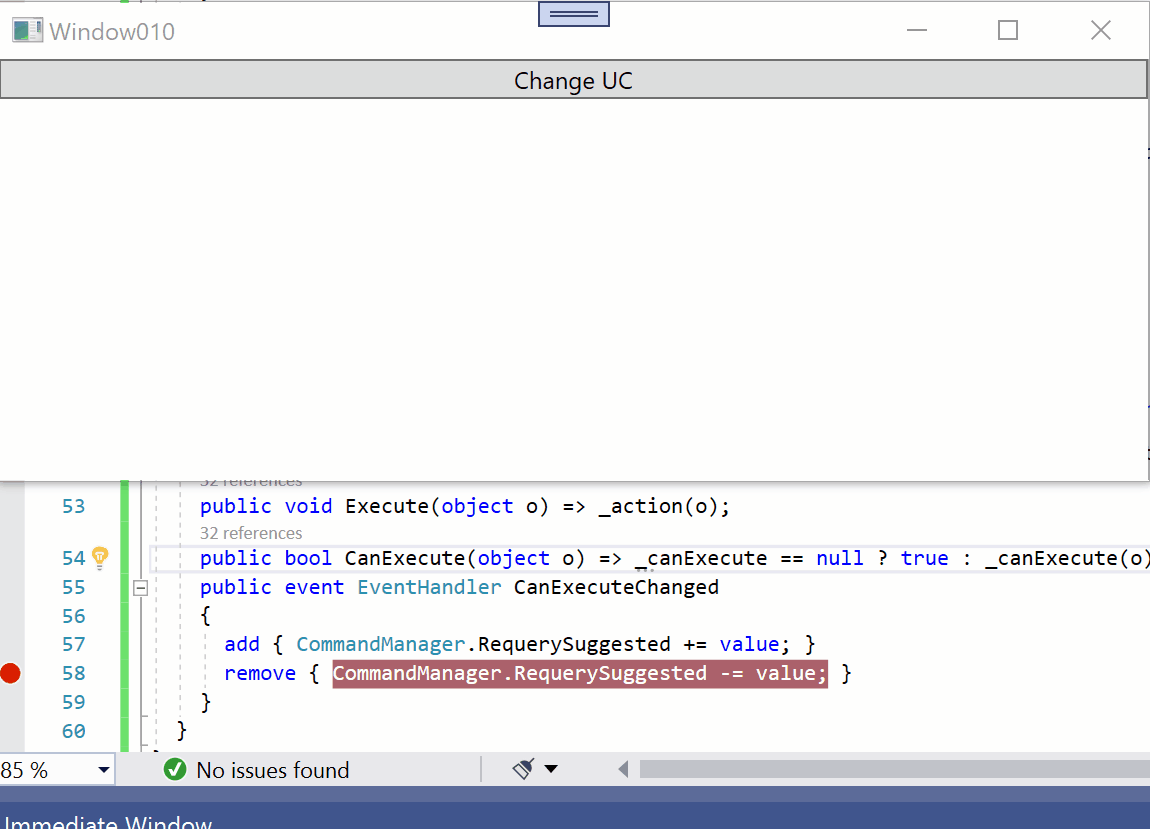Hi,
try following demo and you can see RemoveHandler when Button will be destroyed.
XAML MainWindow:
<Window x:Class="WpfApp1.Window010"
xmlns="http://schemas.microsoft.com/winfx/2006/xaml/presentation"
xmlns:x="http://schemas.microsoft.com/winfx/2006/xaml"
xmlns:d="http://schemas.microsoft.com/expression/blend/2008"
xmlns:mc="http://schemas.openxmlformats.org/markup-compatibility/2006"
xmlns:local="clr-namespace:WpfApp010"
mc:Ignorable="d"
Title="Window010" Height="450" Width="800">
<Window.DataContext>
<local:ViewModel/>
</Window.DataContext>
<StackPanel>
<Button Content="Change UC" Command="{Binding Cmd}" CommandParameter="ChangeUC"/>
<ContentControl Content="{Binding UC}"/>
</StackPanel>
</Window>
ViewModel and RelayCommand:
using System;
using System.ComponentModel;
using System.Runtime.CompilerServices;
using System.Windows;
using System.Windows.Controls;
using System.Windows.Input;
using WpfControlLibrary1;
namespace WpfApp010
{
public class ViewModel : INotifyPropertyChanged
{
public UserControl UC { get; set; }
public ICommand Cmd { get => new RelayCommand(CmdExec, CanCmdExec); }
private void CmdExec(Object parameter)
{
switch (parameter.ToString())
{
case "ChangeUC":
UC = new Window010UC1();
OnPropertyChanged(nameof(UC));
break;
default:
break;
}
}
private bool CanCmdExec(object obj) => true;
public event PropertyChangedEventHandler PropertyChanged;
private void OnPropertyChanged([CallerMemberName] string propName = "") => PropertyChanged?.Invoke(this, new PropertyChangedEventArgs(propName));
}
public class RelayCommand : ICommand
{
private readonly Predicate<object> _canExecute;
private readonly Action<object> _action;
public RelayCommand(Action<object> action) { _action = action; _canExecute = null; }
public RelayCommand(Action<object> action, Predicate<object> canExecute) { _action = action; _canExecute = canExecute; }
public void Execute(object o) => _action(o);
public bool CanExecute(object o) => _canExecute == null ? true : _canExecute(o);
public event EventHandler CanExecuteChanged
{
add { CommandManager.RequerySuggested += value; }
remove { CommandManager.RequerySuggested -= value; }
}
}
}
XAML UserControl:
<UserControl x:Class="WpfControlLibrary1.Window010UC1"
xmlns="http://schemas.microsoft.com/winfx/2006/xaml/presentation"
xmlns:x="http://schemas.microsoft.com/winfx/2006/xaml"
xmlns:mc="http://schemas.openxmlformats.org/markup-compatibility/2006"
xmlns:d="http://schemas.microsoft.com/expression/blend/2008"
xmlns:local="clr-namespace:WpfControlLibrary1"
mc:Ignorable="d"
d:DesignHeight="450" d:DesignWidth="800">
<Grid>
<Button Content="Button in UserControl" Command="{Binding Cmd}"/>
</Grid>
</UserControl>
Result:

